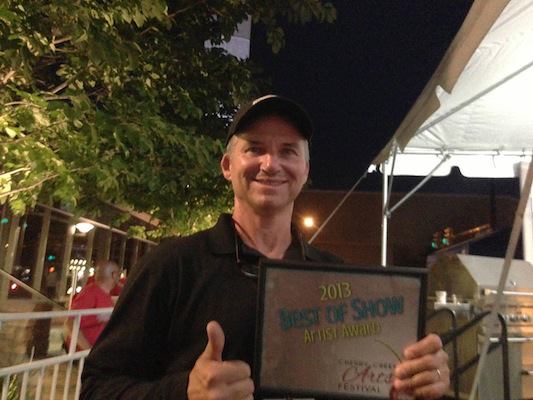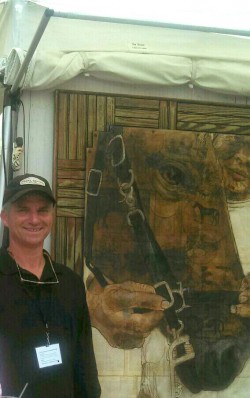This is part of a series of posts highlighting the art fair and festival industry.
Creative Conversations with… Mixed Media Artist Aaron Hequembourg
In spite of his amazingly-full schedule, Georgia-based artist Aaron Hequembourg sat down with the ZAPP® team to discuss his background, artistic inspiration, and his perspective on the future of the art fair field. When Hequembourg is not traveling the country — and winning numerous show awards! — you can find him at his picturesque Georgia farm salvaging materials for his next creative masterpiece.

What did you do before you began to do art fairs and what brought you into this field? How long have you been a working artist?
Before I began art fairs, I participated in high-end antique shows. Looking back now, it was a great boot camp for art fairs [because of the] loading, unloading, presentation, [and need to] inform your viewers without overwhelming them. It was a great education!
How long have you been making your engraved paintings? What inspired this process, and how do you choose the subject matter for each painting?
Graduating from college and not having a press, I started producing engraved paintings — very contemporary abstracted figures. In 1997, I got married and moved to a farm that has been in my wife Hope’s family since 1815. After a few years, her uncle, the patriarch of the family, suggested I get a permit and burn down the sharecropper houses that were scattered over the farm. Initially affected by the history of the land and buildings, I researched period photographs for subject matter. In the last four years or so, I started using my neighbors and members of the community as subjects, paying each of them 10% of proceeds from each sale. This has changed my life.
“In the last four years or so, I started using my neighbors and members of the community as subjects, paying each of them 10% of proceeds from each sale. This has changed my life.”
What’s your studio or sketching process like?
My studio is a WWII, army surplus Quonset hut that Hope’s grandfather placed on the farm. I do a photo study of my subjects for each piece, make adjustments for reference in Photoshop, and then sketch onto the materials from those images.
What has been your favorite or most encouraging experience at an art show?
I guess the first time someone became overwhelmed with emotions at a show. It was at Coconut Grove Arts Festival about four years ago when a mature gentleman was moved to tears in my booth. Since then, and as my work has become revolved around personal stories, there are usually three to four emotional responses at each show.
What made you choose to do art shows over galleries and museums?
I only used to use galleries. Then I married the gallery. Then as the family grew, the gallery closed. Before I found a new gallery, I was going to make a body of work that I sold myself. I’ve never had the opportunity to find a new gallery because my sales and response have easily been three times [more than] any gallery experience.

How do you plan out your schedule every year?
I plan my year by applying to the best and filling in the rest. I’ve learned from the veterans to overbook. if you have a full schedule and have a great show somewhere, you can cancel the next event if necessary. If you book a light schedule and have a bad show, you have a full van and nowhere to drive it to.
“I plan my year by applying to the best and filling in the rest.”
As an artist who has been exhibiting in fairs and festivals for several years, what are some trends and shifts that you have witnessed in this business?
It’s hard to say, but I have had the best year of my career, and for me it has been primarily high-end pieces. I haven’t produced anything for the booth under $1,000 dollars since March of 2013. I still have one example of a smaller, more affordable work on hand but rarely has anyone asked “do you have more pieces this size?” I’m trying not to over-analyze it, but if the market is buying the large pieces, that is what I would prefer to make anyway.
What do you see for the future of art fairs and festivals? Where do you hope they are headed and what do you see as threats to the industry?
My concern for the future of art fairs is their success. The great shows get greater; however, not all shows attract bigger crowds and keep high-end customers. I wonder “is there a tipping point where a great show becomes a larger, different kind of event?” It’s hard to say, and even worse to learn the hard way.
If you could have given one piece of advice to yourself five years ago, what would it be? Any advice for artists just joining the industry?
Don’t be afraid to produce evocative, subject-driven work for fear of not being aesthetically marketable. Do good work that is fulfilling, and the money will show up. To someone just joining the industry, there are many manufacturers of great chairs for art show artists. Do not buy or bring a chair to an art show. Stay on your feet and address and engage the people that come into your booth. If people are not buying, watch what they watch, see what they are drawn to and not drawn to.This industry offers constant market research, which affords us to make meaningful work and be aware of what the public thinks of it — even if they don’t make a purchase.
“Don’t be afraid to produce evocative, subject-driven work for fear of not being aesthetically marketable.”
If you’ll be in the Denver area Nov. 14-16, 2014, you can catch Hequembourg at ArtDenver (booth #8), the new show produced by the Cherry Creek Arts Festival. You can also view more of his work on his website, http://www.bigwhitedog.net/.

